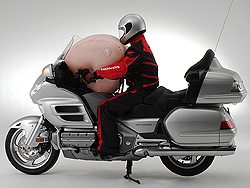Airbags for Gold Wings
TOKYO, Japan, September 8, 2005 – Honda Motor Co., Ltd. today announced it has succeeded in developing the world’s first production motorcycle airbag system.
The new system is claimed to help lessen the severity of injuries caused by frontal collisions.
It is to be made available on the new Gold Wing motorcycle scheduled for release in late spring of 2006 in the US.
Motorcycle Airbag System
The Motorcycle Airbag System is comprised of the airbag module, which includes the airbag and the inflator; crash sensors, which monitor acceleration changes.
It also includes an ECU, which performs calculations to instantly determine when a collision is occurring.
When a severe frontal collision occurs, the four crash sensors mounted on the front fork measure the change in acceleration caused by the impact.
They convey this data to the airbag ECU, which determines that a collision is occurring and whether or not it is necessary to inflate the airbag.
If the calculations performed by the ECU indicate that airbag deployment is necessary, the ECU sends an electronic signal to the airbag inflator, which instantaneously responds by inflating the airbag.
Inflating rapidly after the impact, the airbag can absorb some of the forward energy of the rider, reducing the velocity at which the rider may be thrown from the motorcycle and helping lessen the severity of injuries caused by the rider colliding with another vehicle or with the road.
By conducting extensive crash tests at its indoor omni-directional Real World Crash Test Facility, applying advanced computer simulation technology, and leading the way with the introduction of motorcycle rider test dummies, Honda has gathered and analyzed a wide array of data on the behavior of motorcycles during collisions.
Honda has also taken full advantage of the experience of its automobile operations in the development of airbags, applying its expertise in the development of the Motorcycle Airbag System.
Where to Buy Honda Motorcycle Airbag
Check Reviews & Prices on AmazonSee More: Motorcycle Accessories, Motorcycle Tire, Motorcycle Helmets
Motorcycle Airbag System: Principal Components
- The airbag module, containing the airbag and inflator, is positioned in front of the rider.
- The airbag ECU, positioned to the right of the module , analyzes signals from the crash sensors to determine whether or not to inflate the airbag.
- Four crash sensors attached on both sides of the front fork detect changes in acceleration caused by frontal impacts.
Functions of the Principal Components
Airbag Module: The airbag module contains the airbag and airbag inflator. The airbag inflator receives an electronic signal transmitted by the airbag ECU instructing it to release nitrogen gas to inflate the airbag. The airbag starts to inflate, exerting pressure on the cover of the airbag module, forcing it to open.
The size and shape of the airbag, the manner in which is secured to the motorcycle with tethers, and the function of the deflation vents all help to maximize the effectiveness with which the system absorbs the kinetic energy of the rider, helping control the velocity at which the rider may tend to be thrown forward from the motorcycle, and thus lessening the severity of any injuries resulting from impact with another vehicle or with the road.
Honda claims that It takes only 0.060 seconds* from the moment an impact is recognized as a collision to the moment of airbag inflation.
Airbag ECU: The airbag ECU continuously monitors the data received from the crash sensors, and by comparing this data to standard vehicle behavior, determines whether or not it is necessary to deploy the airbag.
The data from each sensor is evaluated independently, and if it is determined to deviate from programmed standards of safe vehicle behavior by a certain predetermined degree, an electronic signal is sent to the airbag inflator, which causes the airbag to inflate.
Crash Sensors: The crash sensors which monitor acceleration changes are attached to the front fork legs to optimize the quickness and accuracy of their detection of frontal impacts. No alteration of the structure of the motorcycle is needed. To optimize the accuracy of collision detection, a set of 4 sensors are arranged—two on each side of the front fork.
*Side collision with a stationary vehicle (Honda Accord) at 50km/h
Where to Buy Honda Motorcycle Airbag
Check Reviews & Prices on AmazonSee More: Motorcycle Accessories, Motorcycle Tire, Motorcycle Helmets
Owner Comments and Feedback
See details on submitting comments.


